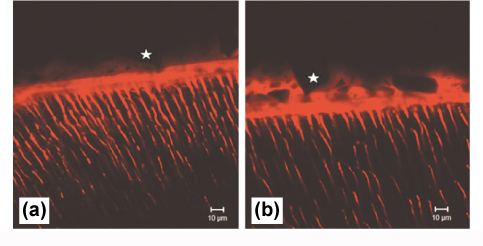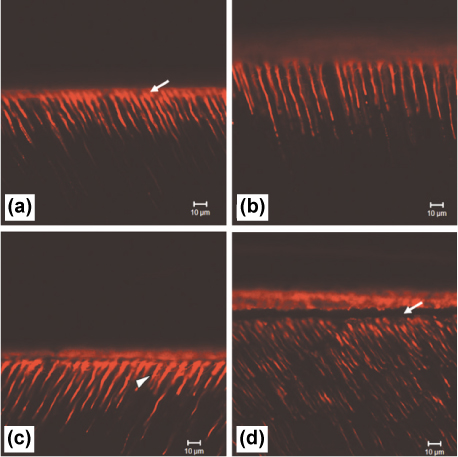J Korean Acad Conserv Dent.
2011 Nov;36(6):490-497. 10.5395/JKACD.2011.36.6.490.
Bonding efficacy of cured or uncured dentin adhesives in indirect resin
- Affiliations
-
- 1Department of Conservative Dentistry, Chonnam National University School of Dentistry, Gwangju, Korea. hinso@chonnam.ac.kr
- KMID: 2176603
- DOI: http://doi.org/10.5395/JKACD.2011.36.6.490
Abstract
OBJECTIVES
This study examined the effect of the uncured dentin adhesives on the bond interface between the resin inlay and dentin.
MATERIALS AND METHODS
Dentin surface was exposed in 24 extracted human molars and the teeth were assigned to indirect and direct resin restoration group. For indirect resin groups, exposed dentin surfaces were temporized with provisional resin. The provisional restoration was removed after 1 wk and the teeth were divided further into 4 groups which used dentin adhesives (OptiBond FL, Kerr; One-Step, Bisco) with or without light-curing, respectively (Group OB-C, OB-NC, OS-C and OS-NC). Pre-fabricated resin blocks were cemented on the entire surfaces with resin cement. For the direct resin restoration groups, the dentin surfaces were treated with dentin adhesives (Group OB-D and OS-D), followed by restoring composite resin. After 24 hr, the teeth were assigned to microtensile bond strength (microTBS) and confocal laser scanning microscopy (CLSM), respectively.
RESULTS
The indirect resin restoration groups showed a lower microTBS than the direct resin restoration groups. The microTBS values of the light cured dentin adhesive groups were higher than those of the uncured dentin adhesive groups (p < 0.05). CLSM analysis of the light cured dentin adhesive groups revealed definite and homogenous hybrid layers. However, the uncured dentin adhesive groups showed uncertain or even no hybrid layer.
CONCLUSIONS
Light-curing of the dentin adhesive prior to the application of the cementing material in luting a resin inlay to dentin resulted in definite, homogenous hybrid layer formation, which may improve the bond strength.
Keyword
MeSH Terms
Figure
Reference
-
1. Jayasooriya PR, Pereira PN, Nikaido T, Burrow MF, Tagami J. The effect of a "resin coating" on the interfacial adaptation of composite inlays. Oper Dent. 2003. 28:28–35.2. Tyas MJ, Anusavice KJ, Frencken JE, Mount GJ. Minimal intervention dentistry-a review. FDI commission project 1-97. Int Dent J. 2000. 50:1–12.3. Silikas N, Eliades G, Watts DC. Light intensity effects on resin-composite degree of conversion and shrinkage strain. Dent Mater. 2000. 16:292–296.
Article4. Jayasooriya PR, Pereira PN, Nikaido T, Tagami J. Efficacy of a resin coating on bond strengths of resin cement to dentin. J Esthet Restor Dent. 2003. 15:105–113.
Article5. Udo T, Nikaido T, Ikeda M, Weerasinghe DS, Harada N, Foxton RM, Tagami J. Enhancement of adhesion between resin coating materials and resin cements. Dent Mater J. 2007. 26:519–525.
Article6. Hikita K, Van Meerbeek B, De Munck J, Ikeda T, Van Landuyt K, Maida T, Lambrechts P, Peumans M. Bonding effectiveness of adhesive luting agents to enamel and dentin. Dent Mater. 2007. 23:71–80.
Article7. Carvalho RM, Pegoraro TA, Tay FR, Pegoraro LF, Silva NR, Pashley DH. Adhesive permeability affects coupling of resin cements that utilise self-etching primers to dentine. J Dent. 2004. 32:55–65.
Article8. Magne P, Kim TH, Cascione D, Donovan TE. Immediate dentin sealing improves bond strength of indirect restorations. J Prosthet Dent. 2005. 94:511–519.
Article9. Mota CS, Demarco FF, Camacho GB, Powers JM. Tensile bond strength of four resin luting agents bonded to bovine enamel and dentin. J Prosthet Dent. 2003. 89:558–564.
Article10. Ozturk N, Aykent F. Dentin bond strengths of two ceramic inlay systems after cementation with three different techniques and one bonding system. J Prosthet Dent. 2003. 89:275–281.
Article11. Ferrari M, Vichi A, Grandini S. Efficacy of different adhesive techniques on bonding to root canal walls: an SEM investigation. Dent Mater. 2001. 17:422–429.
Article12. Lee JI, Park SH. The effect of three variables on shear bond strength when luting a resin inlay to dentin. Oper Dent. 2009. 34:288–292.
Article13. Magne P, So WS, Cascione D. Immediate dentin sealing supports delayed restoration placement. J Prosthet Dent. 2007. 98:166–174.
Article14. Pashley EL, Comer RW, Simpson MD, Horner JA, Pashley DH, Caughman WF. Dentin permeability: sealing the dentin in crown preparations. Oper Dent. 1992. 17:13–20.15. Dong CC, McComb D, Anderson JD, Tam LE. Effect of mode of polymerization of bonding agent on shear bond strength of autocured resin composite luting cements. J Can Dent Assoc. 2003. 69:229–234.16. Dietschi D, Herzfeld D. In vitro evaluation of marginal and internal adaptation of class II resin composite restorations after thermal and occlusal stressing. Eur J Oral Sci. 1998. 106:1033–1042.
Article17. Lee HB, Han CH, Shim JS, Kim S. The comparison of microtensile bond stength with immediate and delayed dentin sealing. J Korean Acad Prosthodont. 2008. 46:372–380.18. D'Alpino PH, Pereira JC, Rueggeberg FA, Svizero NR, Miyake K, Pashley DH. Efficacy of composite surface sealers in sealing cavosurface marginal gaps. J Dent. 2006. 34:252–259.19. D'Alpino PH, Pereira JC, Svizero NR, Rueggeberg FA, Pashley DH. Use of fluorescent compounds in assessing bonded resin-based restorations: a literature review. J Dent. 2006. 34:623–634.20. Kim DJ, Hwang YC, Kim SH, Oh WM, Hwang IN. Effect of dentinal tubules orientation on penetration pattern of dentin adhesives using confocal laser scanning microscopy. J Korean Acad Conserv Dent. 2003. 28:392–401.
Article21. Pioch T, Stotz S, Staehle HJ, Duschner H. Applications of confocal laser scanning microscopy to dental bonding. Adv Dent Res. 1997. 11:453–461.
Article22. Kanno T, Ogata M, Foxton RM, Nakajima M, Tagami J, Miura H. Microtensile bond strength of dual-cure resin cement to root canal dentin with different curing strategies. Dent Mater J. 2004. 23:550–556.
Article23. Magne P. Immediate dentin sealing: a fundamental procedure for indirect bonded restorations. J Esthet Restor Dent. 2005. 17:144–154.
Article24. Labella R, Lambrechts P, Van Meerbeek B, Vanherle G. Polymerization shrinkage and elasticity of flowable composites and filled adhesives. Dent Mater. 1999. 15:128–137.
Article25. Mak YF, Lai SC, Cheung GS, Chan AW, Tay FR, Pashley DH. Micro-tensile bond testing of resin cements to dentin and an indirect resin composite. Dent Mater. 2002. 18:609–621.
Article26. Monticelli F, Ferrari M, Toledano M. Cement system and surface treatment selection for fiber post luting. Med Oral Patol Oral Cir Bucal. 2008. 13:E214–E221.27. Goracci C, Sadek FT, Fabianelli A, Tay FR, Ferrari M. Evaluation of the adhesion of fiber posts to intraradicular dentin. Oper Dent. 2005. 30:627–635.28. Valandro LF, Filho OD, Valera MC, de Araujo MA. The effect of adhesive systems on the pullout strength of a fiberglass-reinforced composite post system in bovine teeth. J Adhes Dent. 2005. 7:331–336.29. De Munck J, Van Landuyt K, Peumans M, Poitevin A, Lambrechts P, Braem M, Van Meerbeek B. A critical review of the durability of adhesion to tooth tissue: methods and results. J Dent Res. 2005. 84:118–132.
Article30. Peumans M, Kanumilli P, De Munck J, Van Landuyt K, Lambrechts P, Van Meerbeek B. Clinical effectiveness of contemporary adhesives: a systematic review of current clinical trials. Dent Mater. 2005. 21:864–881.
Article31. Tay FR, Pashley DH. Dental adhesives of the future. J Adhes Dent. 2002. 4:91–103.32. Tay FR, Pashley DH, Suh BI, Carvalho R, Itthagarun A. Single-step adhesives are permeable membranes. J Dent. 2002. 30:371–382.
Article
- Full Text Links
- Actions
-
Cited
- CITED
-
- Close
- Share
- Similar articles
-
- The effect of bonding resin on bond strength of dual-cure resin cements
- The comparison of microtensile bond strength with immediate and delayed dentin sealing
- Shear bond strength and failure patterns according to the material of resin base in indirect racket bonding
- Influence of adhesive application on shear bond strength of the resin cement to indirect resin composite
- Effect of calcium hydroxide on bond strength of dentin bonding systems




